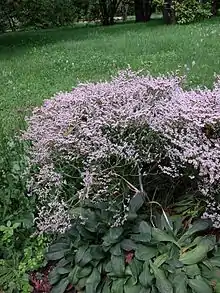Goniolimon tataricum
Goniolimon tataricum is a species of flowering plant in the genus Goniolimon, family Plumbaginaceae.[4] It is called German statice, Tatarian sea-lavender, Tartarian statice or just statice. It is native to Albania, Algeria, Bulgaria, Greece, Kazakhstan, the North Caucasus, Romania, Southern Russia, Tunisia, Ukraine and the former Yugoslavia.[2][5] It is planted in gardens as a border and ground cover, and also used in the cut flower industry.[6]
| Goniolimon tataricum | |
|---|---|
 | |
| Scientific classification | |
| Kingdom: | Plantae |
| Clade: | Tracheophytes |
| Clade: | Angiosperms |
| Clade: | Eudicots |
| Order: | Caryophyllales |
| Family: | Plumbaginaceae |
| Genus: | Goniolimon |
| Species: | G. tataricum |
| Binomial name | |
| Goniolimon tataricum | |
| Synonyms[2] | |
Varieties
Two varieties are currently accepted:[2]
- Goniolimon tataricum var. platypterum (Klokov) Tzvelev
- Goniolimon tataricum var. tauricum (Klokov) Tzvelev
References
- A.P.de Candolle, Prodr. 12: 632 (1848)
- "Goniolimon tataricum (L.) Boiss". Plants of the World Online. Board of Trustees of the Royal Botanic Gardens, Kew. 2017. Retrieved 4 September 2020.
- GBIF Backbone Taxonomy. "Taxanthema tatarica Sw". gbif.org. GBIF Secretariat. Retrieved 4 September 2020.
- "Goniolimon tataricum (L.) Boiss". World Flora Online. The World Flora Online Consortium. n.d. Retrieved September 19, 2020.
- "Goniolimon tataricum statice". The Royal Horticultural Society. Retrieved 4 September 2020.
- "Goniolimon tataricum". missouribotanicalgarden.org. Missouri Botanical Garden. Retrieved 4 September 2020.
This article is issued from Wikipedia. The text is licensed under Creative Commons - Attribution - Sharealike. Additional terms may apply for the media files.